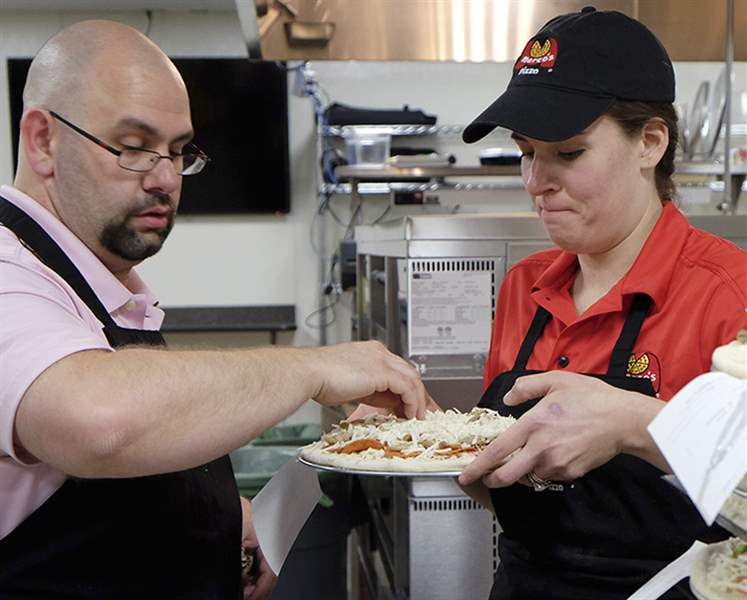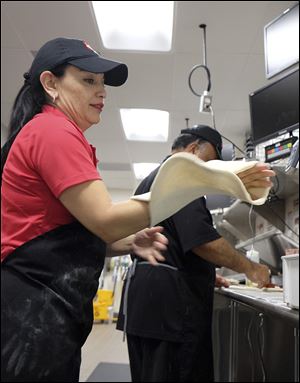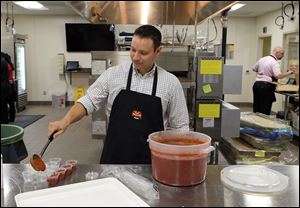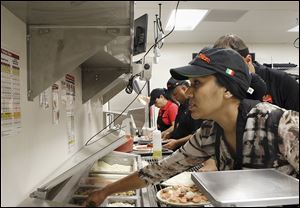
Pizza U. rises to the occasion
Toledo’s Marco’s pizza chain teaches franchise owners to make dough
8/30/2015
Trainer Chuck Blevins of Lincoln Park, Mich., spreads cheese on a pizza held by Sara Ragsdale of Charleston, S.C., in Marco’s new test kitchen on Monroe Street. Marco’s was named the second-fastest growing chain in the nation.
THE BLADE/JETTA FRASER
Buy This Image

Trainer Chuck Blevins of Lincoln Park, Mich., spreads cheese on a pizza held by Sara Ragsdale of Charleston, S.C., in Marco’s new test kitchen on Monroe Street. Marco’s was named the second-fastest growing chain in the nation.
Ed Alimi flew this month nearly 2,000 miles from his San Diego home to Toledo to learn how not to make a pizza.
He could have stayed home, bought a pie from a local pizzeria, ate it, and learned absolutely nothing. But as a new franchisee of Toledo’s Marco’s Pizza, Mr. Alimi is keen to make his budding pizza franchise succeed.
“That’s the whole idea of being at the corporate office, he said. ”They teach us the best way to make a pizza and how not to make a pizza.”
His Toledo training included a week at “Marco’s Pizza University,” a $500,000 training kitchen and research and development facility that the pizza company opened six months ago at its headquarters at 5252 Monroe St.
The test kitchen and R&D center is used for many purposes, including testing new products, said Bryon Stephens, president and chief executive officer of Marco’s Franchising LLC, which operates Marco’s Pizza. “But the biggest reason for having it is we use it as a training facility for all our franchisees coming in,” he said.
Until last year, Marco’s gave its new franchisees a week of classroom time at its headquarters to cover business issues, then took them to a local store to practice making pizzas and other food items.
“That was OK, but it didn’t provide the most optimal training period,” Mr. Stephens said. “You had to contend with the business that was coming in the store. It was a really slow way to educate people, and it was stressful.”

Delmy Lopez of Smyrna, Ga., stretches dough for a medium-sized pizza. Behind her, Ed Alimi of San Diego, applies sauce to a crust.
With the 3,500-square-foot test kitchen, franchisees can learn the process “without being under fire,” he said.
Marco’s, which had $338 million in sales in 2014, decided that its big push to add franchises spurred the need for the kitchen training site.
Privately held Marco’s, which began in 1978 and recently was named the second-fastest growing large chain in the country by the Nation's Restaurant News, has 640 stores in 35 states and the Bahamas, including 141 restaurants added in the last year. It says it is on track to quadruple its store count by 2022.
It plans to open 150 stores by the end of this year, and recently it finalized deals for 400 new stores in India over the next 10 years and 40 stores in Puerto Rico over the next nine.
Four years ago it was adding 20 to 40 stores a year, but now is doing 150 to 175, Mr. Stephens said.
“We started to realize that in order to have 10 to 12 people in a training class at one time, to keep that one-on-one element, we needed to do a reboot,” the chief executive officer said.
Lynn Liddle, a Domino’s Pizza executive who is chairman of the American Pizza Community, a lobbying organization whose members include most of the nation’s largest pizza chains — but not Marco’s — said it is common for pizza companies to have test kitchens.
Such test kitchens are used to “test recipes and operational aspects of our products, conduct training or demonstrations,” Ms. Liddle said.
“Pizza is a handmade, fresh product in many cases and requires the same care and artistry as any food recipe would,” she added.
Marla Topliff, chairman of the National Restaurant Association’s Pizzeria Council, said of a test kitchen, “It gives [franchisees] the opportunity to slow down and learn things the right way.”

Robert Tankoos of Charlotte ladles marinara sauce into small cups to accompany cheesy bread orders. Mr. Tankoos, who is originally from Toledo, and the other franchisees put their skills to the test at Marco’s Pizza corporate office.
“If you’re a larger chain like Marco’s, this is an excellent move, because when you’re bringing in franchisees you need a place to train them according to to your recipes,” said Ms. Topliff, president of Rosati’s Pizza in Chicago. And, she added, it is cheaper than sending out training teams.
“Plus, it’s very difficult to train someone out in the field,” she said. “We do our training in our main corporate store. Frankly, the kitchen isn’t large enough. It’s just too small, plus you want the best possible training setting you can get,” she said.
As a bonus, a test kitchen gives a chain the place to develop new recipes. “Recipes can take a long time to develop. It could take up to several months,” Ms. Topliff said.
Mr. Stephens said Marco’s shows franchisees not only how to make the perfect pizza, but how pizza-making can go wrong.
“We’ll have them purposely make dough wrong on occasion so they can see what would happen without a particular ingredient, what happens to our dough without the proper water, what happens when the water is too warm or the water is too cold,” the CEO said. “It’s one thing to know what looks wrong in theory. This way they’ll know what it looks like in practice.”
Not only does the training help with quality assurance, he said, it also means the trainees see something happen, such as a pizza crust that doesn’t rise properly, and then they will know what to do, something maybe they wouldn’t realize if they had previously seen it.
Franchisees get a certificate for completing Pizza University training, which includes a week of classes, followed by six weeks in the field at a franchisee in their home region, then a final week in the test kitchen.
“They come back here so we can thoroughly test them,” Mr. Stephens said.
Mr. Alimi, a former IT specialist with the U.S. Department of Homeland Security, spent his six weeks at a store in Salt Lake City. There are only a handful of Marco’s Pizza stores in California, he said.

BIZ pizza19p Iffy (cq) Momin (cq), of Decatur, Alabama, checks how much green pepper to put on a pizza. Marco's Pizza franchise trainees polish their skills in the expanding pizza business' new test kitchen in Toledo, Ohio on August 19, 2015. The Blade/Jetta Fraser
In fact, Mr. Alimi is the first franchisee in San Diego. When he went looking for a career change and decided on a food franchise, he and his family had to drive two hours to Los Angeles just to find a Marco’s pizza to taste.
“We did a test, and everybody likes it. It’s fresh, very fresh dough and ingredients. I’m sure everybody in San Diego is going to like Marco’s Pizza,” said Mr. Alimi, who paid between $300,000 and $500,000 for his franchise. Marco’s said that the average cost for one of its franchises is $350,000.
Besides training franchisees, The Marco’s test kitchen gives the company a secluded place to plan and test potential new menu items. Recently, two flavors of brownie desserts — a Ghirardelli Double Chocolate version and a S’mores version — emerged from the kitchen after some experimentation.
It also successfully designed three limited-time specialty pizzas in the kitchen — a spicy fresco pizza, a grilled chicken florentine, and a Roma meats pizza.
“Our desserts lineup is something that we look at on our menu mix all the time,” Mr. Stephens said. “But we’ll look ... beverages, pizzas, salads, sandwiches, sides, breadsticks, and desserts.”
After testing new products in the test kitchen, they are tested with customers in one or two areas. Before, initial testing was done in stores, and the customers expected that product to be on the menu later, and it may have been scrubbed. Plus, in a test kitchen, there’s more confidentiality on new products, Mr. Stephens said.
And, the test provides a place to test out new equipment, something to improve the efficiency, checked out initially without affecting an operating store.
Contact Jon Chavez at: jchavez@theblade.com or 419-724-6128.